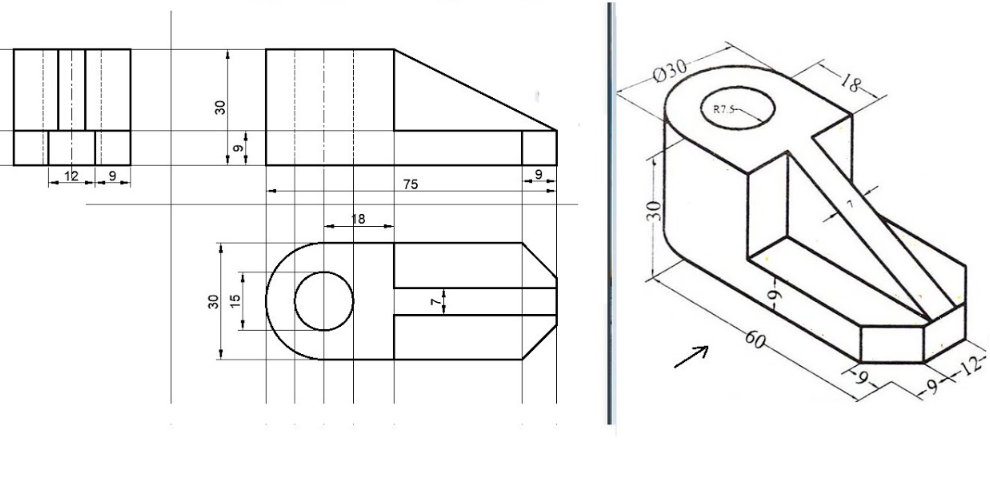One of the foundational facets of technical drawing is the use of different views– each providing unique understandings right into the dimensions, shape, and details of an item. The key views in technical drawing consist of the front sight, leading sight, side view, section view, isometric view, and others, each playing a specific role in interacting vital details to designers, fabricators, and engineers.
The façade is frequently the most identifiable facet of a technical drawing. It provides the most insightful viewpoint of a things, catching its height and width while covering deepness. This sight is usually the initial drawing to be created and offers as the reference factor for creating additional views. The primary objective of the façade is to deliver a clear, uncomplicated representation of the object that stresses essential attributes, measurements, and proportions. This view supports the drawing process, permitting developers to function from this standard point of view, making certain that subsequent views align appropriately and that all featuresline up as planned.
Building upon this, the top sight matches the front sight by providing information regarding the depth of the item. This sight allows developers to see just how broad and deep the object is, eliminating obscurity that might emerge from the first front view alone.
The side view, additionally understood as the account view, offers yet one more point of view by showing the object’s elevation and depth. By including the side view right into the technical drawing, developers make sure that all measurements can be properly offered, creating a comprehensive view of the things.
Discover technical drawing views the crucial function of technical drawing in design and architecture, highlighting crucial views such as front, top, side, section, and isometric viewpoints that guarantee precise interaction and execution in style and production.
Section views are one more essential element of technical drawings. They give a means to show the interior functions of a layout that may not be noticeable from the outside views. A section sight is produced by cutting through the things and subjecting its internal geometry. This technique enables designers and designers to check out intricate features such as dental caries, forms, and materials within a style. Including area views aids to stop complication in comprehending the design, particularly for elaborate assemblies where interior setups could impact capability or manufacturability. By developing these cuts in the item, technical drawings end up being extra helpful, permitting for even more extensive assessments of just how parts will communicate as soon as constructed.
This view provides a three-dimensional depiction of the object, providing a practical illusion of depth and range without calling for intricate point of view estimations. Isometric views can be incredibly useful in conveying the overall design of an item, specifically to individuals that may not be fluent in reviewing technical illustrations.
In enhancement to these essential views, there are various other kinds of estimates, such as orthographic and perspective forecasts, that offer various features in technical drawing. Orthographic projections are a collection of several views that individually portray the things from various angles, usually in a two-dimensional style.
To successfully develop a technical drawing, it is important to recognize the conventions and signs that represent different features and measurements. Architects and designers utilize various lines– such as strong lines, dashed lines, and centerlines– to convey info concerning sides, features, and crucial areas. Dimensioning is an additional vital part of technical drawing. Appropriate dimensioning provides necessary measurements that dictate how components fit with each other, making sure that styles fulfill necessary tolerances and specifications. Unreliable measurements can result in pricey mistakes throughout manufacturing, making this facet of technical drawing critical for dependability and success.
A number of software program tools and applications promote the technical drawing procedure, improving the traditional hand-drawing methods. Programs like AutoCAD, SolidWorks, and various other Computer-Aided Design (CAD) software application enable users to produce complex 2D and 3D versions with much better precision and adaptability than hand-operated techniques. These tools allow simple modifications, permitting quick prototyping and iteration without the need to recreate illustrations from the ground up. This digital makeover has significantly accelerated the design and production processes throughout various industries, driving innovation and improving efficiency.
In the context of sectors today, understanding just how to apply different views in technical drawing is not only critical for engineers and architects but also for producers, item designers, and even marketing professionals. In collective settings, particularly in areas like building and manufacturing, clear technical illustrations make certain that all stakeholders– from developers to clients– are on the exact same page.
The capacity to from thorough technical drawings, consisting of numerous views, is important for creating components that not only fit with each other correctly but likewise operate effectively as component of broader systems. In addition, as industries shift to automated and electronic procedures, the abilities required to generate and interpret technical illustrations will be important to future ability pipelines.
To conclude, technical drawing encompasses numerous views, each of which plays a particular function in communicating needed information regarding an item. These viewpoints– including front, top, side, section, and isometric views– aid to facilitate and interact intricate ideas understanding among professionals across numerous industries. As technology and approaches for creating technical drawings remain to advance, understanding and executing these views properly stays critical. Not just does this boost clearness and performance in the design and manufacturing worlds, however it additionally promotes advancement, permitting the successful awareness of creative principles and solutions. As we relocate better into a period characterized by quick technical evolution, the concepts of technical drawing and its associated views will definitely remain important fit the future of production, design, and design. Whether in typical contexts or advanced applications, the importance of properly representing concepts will just expand, enhancing the requirement for proficiency in this essential ability.